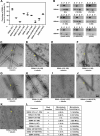This is a preprint.
Structural insights into SSNA1 self-assembly and its microtubule binding for centriole maintenance
- PMID: 39803484
- PMCID: PMC11722292
- DOI: 10.1101/2024.11.13.623454
Structural insights into SSNA1 self-assembly and its microtubule binding for centriole maintenance
Update in
-
Structural insights into SSNA1 self-assembly and its microtubule binding for centriole maintenance.Nat Commun. 2025 Aug 13;16(1):7512. doi: 10.1038/s41467-025-62696-9. Nat Commun. 2025. PMID: 40804232 Free PMC article.
Abstract
SSNA-1 is a fibrillar protein localized at the area where dynamic microtubule remodeling occurs including centrosomes. Despite the important activities of SSNA1 to microtubules such as nucleation, co-polymerization, and lattice sharing microtubule branching, the underlying molecular mechanism have remained unclear due to a lack of structural information. Here, we determined the cryo-EM structure of C. elegans SSNA-1 at 4.55 Å resolution and evaluated its role during embryonic development in C. elegans. We found that SSNA1 forms an anti-parallel coiled-coil, and its self-assembly is facilitated by the overhangs of 16 residues at its C-terminus, which dock on the adjacent coiled-coil to form a triple-stranded helical junction. Notably, the microtubule-binding region is within the triple-stranded junction, highlighting that self-assembly of SSNA-1 facilitates effective microtubule interaction by creating hubs along a fibril. Furthermore, our genetical analysis elucidated that deletion of SSNA-1 resulted in a significant reduction in embryonic viability and the formation of multipolar spindles during cell division. Interestingly, when the ability of SSNA-1 self-assembly was impaired, embryonic viability stayed low, comparable to that of the knockout strain. Our study provides molecular insights into the self-assembly mechanisms of SSNA-1, shedding light on its role in controlling microtubule binding and cell division through the regulation of centriole stability.
Figures






References
-
- Ramos-Morales F, Infante C, Fedriani C, Bornens M, Rios RM. NA14 is a novel nuclear autoantigen with a coiled-coil domain. J Biol Chem. 1998. Jan 16;273(3):1634–9. - PubMed
-
- Pfannenschmid F, Wimmer VC, Rios RM, Geimer S, Kröckel U, Leiherer A, Haller K, Nemcová Y, Mages W. Chlamydomonas DIP13 and human NA14: a new class of proteins associated with microtubule structures is involved in cell division. J Cell Sci. 2003. Apr 15;116(Pt 8):1449–62. - PubMed
Publication types
Grants and funding
LinkOut - more resources
Full Text Sources
Research Materials
